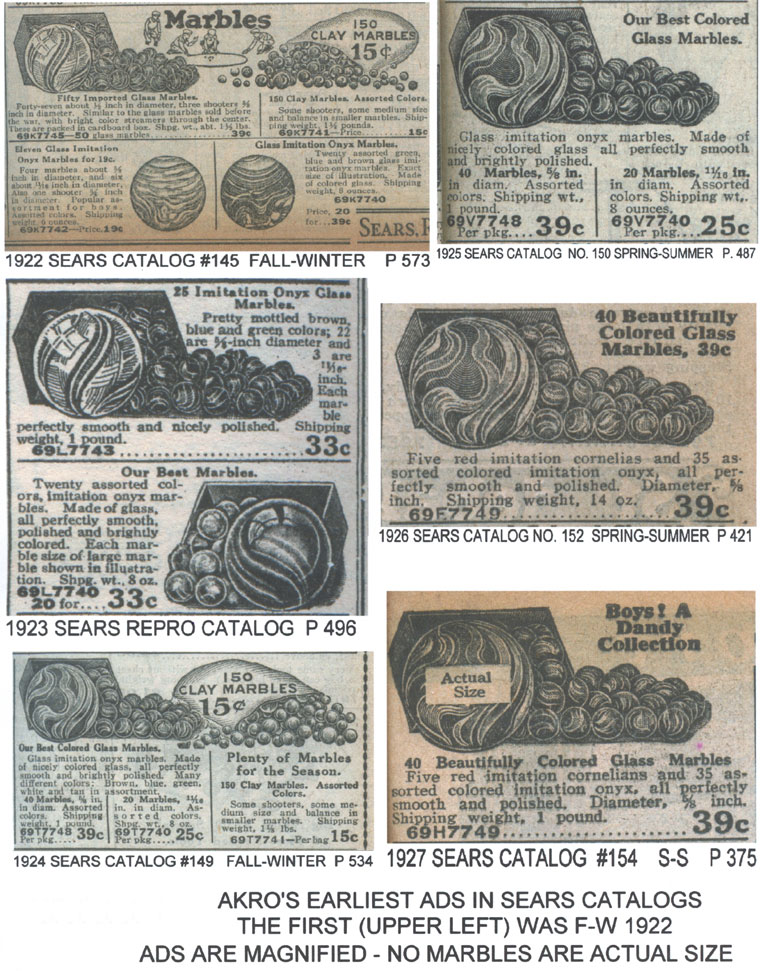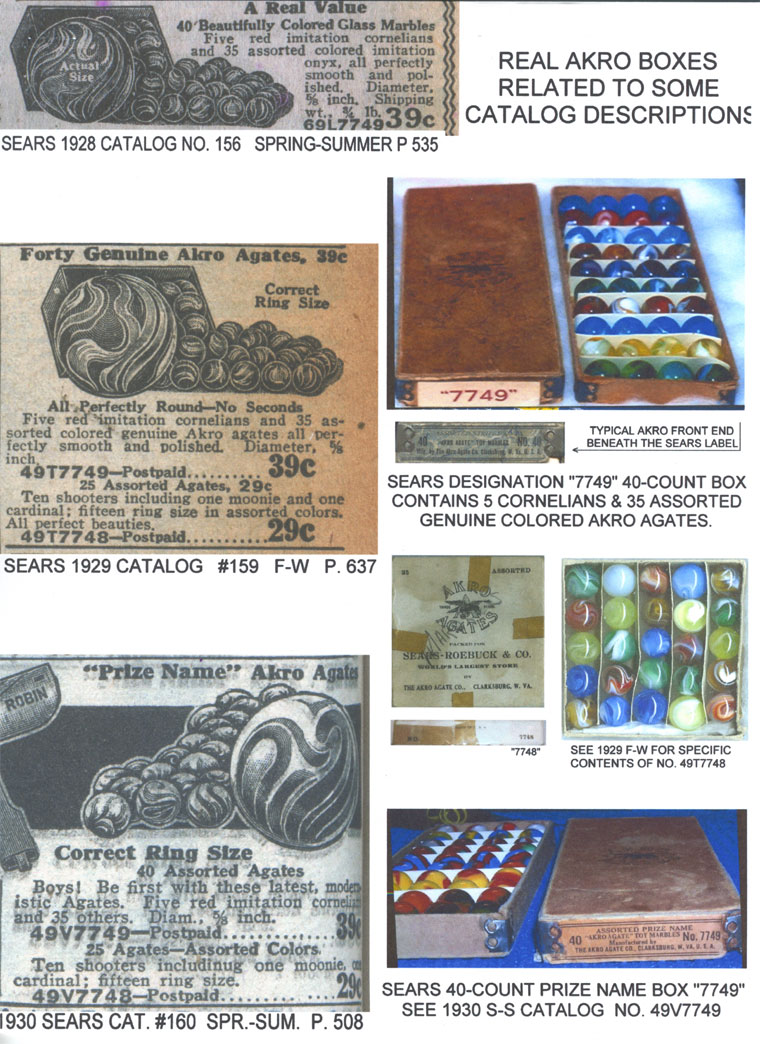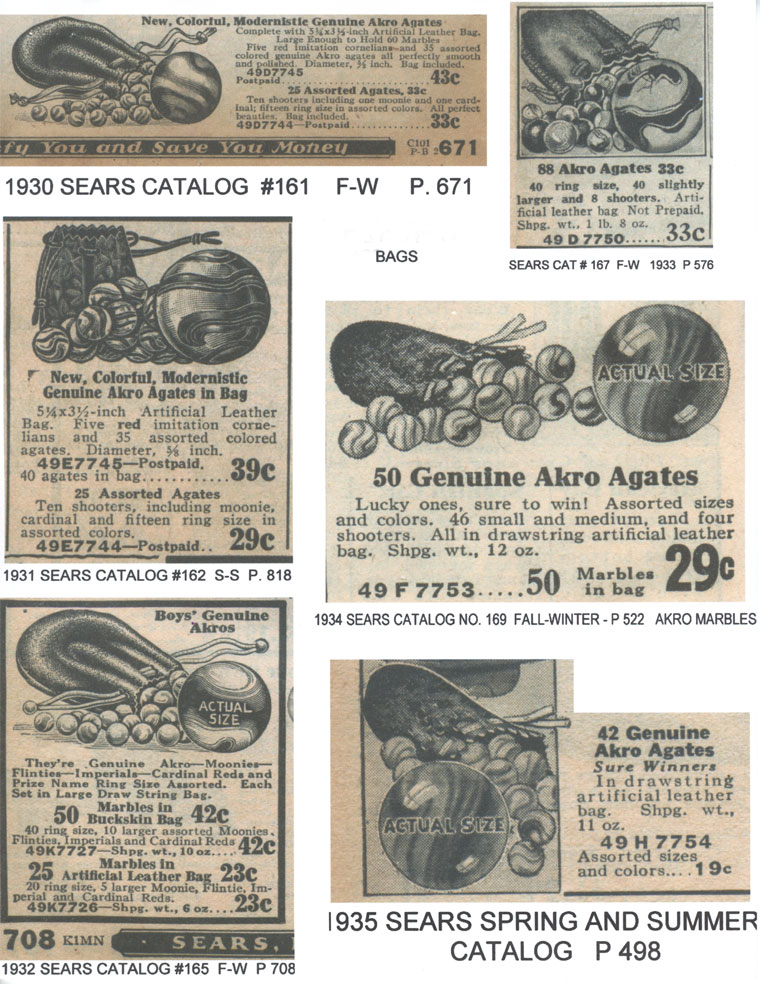

THE AKRO-SEARS CONNECTION
By George Sourlis
In the 1920s and 1930s Sears put out 2 major catalogs each year – 1 in
Spring & Summer (S-S) and 1 in Fall & Winter (F-W).
In the F-W 1922 Sears catalog the first listing for Akro marbles
appeared; in their S-S 1935 catalog was Akro’s last.
In every major Sears catalog in the intervening 12 years Akro marbles
were shown – an impressive run through 14 consecutive years.
In Plates 1, 2, and 3 are shown with 1 listing for each year, except
1930. 1930 was a transition year
from onyx in 1929 to Prize Name marbles (S-S 1930) and then from boxes of
marbles to bags of marbles (F-W 1930).
So both ads for that year are shown.
Plate 1 shows 6 listings, 1 for each of the years from 1922 through 1927.
In 1922 and 1923 both imitation glass onyx and handmade glass marbles
were being sold, but after 1923 handmades were no longer offered.
Handmades were sold in larger quantities in boxes.
While no packaging is specified for the onyx in 1922, they are shown with
a box in 1923. The price for 20 onyx
marbles dropped from 39 cents in 1922 to 33 cents in 1923.
Only 3 colors, brown, blue, and green, were available in the onyx.
No maker is specified for either type, but later listings show Cornelians
mixed with the onyx marbles, and Akro was the only maker of glass Cornelians at
the time.
In 1924 more colors become available, including WHITE.
Both 40 and 20-count boxes were available.
The price for 20 onyx dropped from 33 cents in 1923 to 25 cents, but for
another 14 cents, 39 cents, almost twice as many onyx marbles could be had.
The offering for onyx marbles in 1925 is quite similar to the one in
1924. 20-count and 40-count boxes
were again offered at the same prices, 25 cents and 39 cents, respectively.
Colors were only specified as assorted.
Only 40-count boxes were available in 1926.
5 red imitation Cornelians were introduced as part of the mix; the rest
were onyx. This may be the
introductory year for Akro’s Cornelians, because 1930 was the year Akro’s Prize
Names were introduced, and that was also the year they first appeared in a Sears
catalog.
The description in 1927 is the same as that in 1926.
The price remained at 39 cents.
Over these 6 years some marketing trends are apparent.
The 1922 description offered 3 kinds or marbles: handmades (although no
stated as such), imitation glass onyx, and clays.
By 1927 only imitation glass marbles (Akro’s) were offered.
Quantities varied: 11
imitation onyx. 20 imitation onyx,
50 handmades, and 150 clays in 1922.
By 1927 only quantities of 40 were available.
Apparently this was the most cost-effective number to sell.
In the onyx marbles prices dropped as quantities purchased increased – a
volume discount for the buyer.
Finally, catalog space was conserved by offering 1 box size.
A look at the top of Plate 2 shows repetition in 1928 of the 1927 of the
40-count box at the same price.
There were 2 changes in the 1929 listing.
First, 2 boxes were offered instead of 1.
The same 40-count box is there again at 39 cents.
New is the 25-count at 29 cents.
That’s a 37.5% reduction in number of marbles with about a 25% decrease
in price. In the new box are 2 new
marble types: 1 Moonie and 1
Cardinal (Cardinal Red). Second, for
the first time the Akro name appears in the text.
After this it is present in every catalog through S-S 1935.
A photo of an actual 1929 40-count box is shown to the right of the
catalog listing in Plate 2. Notice
the Sears number, “7749”, pasted on the front end covering the Akro label.
These are the last four digits of the catalog number – 49T7749.
Likewise in the picture of an actual 25-count box the “7748” number on
the cover end relates to Sears’ 49T7748.
In the S-S 1930 catalog (Plate 2) the contents of the 40-count box were
changed. The 35 imitation glass onyx
were replaced by 35 Akro Prize Names.
The price was maintained at 39 cents.
The 25-count box at 29 cents with the same contents was again available.
An actual 40-count Prize Name box is pictured to the right of this last
listing in Plate 2. Notice that its
number is “7749”, the same last 4 digits of the catalog number 49V7749.
At the top left of Plate 3 is shown the F-W 1930 listing with 40 and
25-count BAGS, NOT 40 and 25-count BOXES.
In the 40-count bags were 5 Cornelians and 35 Akro agates.
The 25 count bag held 1 Mooney, 1 Cardinal; 10 of the marbles were
shooters and 15 were ring size. Bags
were described as artificial leather.
Prices were raised from 39 cents for 40 marbles to 43 cents, and from 29
cents for 25 marbles to 33 cents.
Catalog numbers were changed from 49V7749 (40-count box) and 49V7748 (25-count
box) to 49D7745 and 49D7744, respectively
Marble types became more diverse in 1932 featuring Moonies, Imperials,
Flinties, Cardinal Reds, and Prize Names in the 50-count buckskin bag (42 cents)
and in the 25-count artificial leather bag (23 cents).
Catalogs changed to 49K7727 and 49K7726, respectively.
Only a single bag was offered for sale in each of the next 3 years.
In F-W 1933 88 marbles were available for merely 33 cents.
This became 50 marbles for 29 cents in F-W 1934.
Finally there were 42 marbles for 19 cents in S-S 1935.
In none of these bags were the types of marbles specified.
Catalog numbers for the 3 consecutive years were 79D7750, 7979F7753, and
79H7754, respectively.
Many cost-cutting changes are apparent in the 6 years that bags were
offered. Only 2 materials were used
for the bags – buckskin and artificial leather, mostly the later.
In 1930 items were shipped postpaid; by 1933 they were NOT postpaid.
From 1931 to 1933 prices for marbles were lowered until they reached a
low in 1933. Volume discounts were
being given to increase sales, which were dropping as the depression deepened.
Prices rose slightly in 1934 and 1935. Finally,
in 1935 it was no longer cost effective to sell marbles this way, and Sears
ceased listing them for sales in the last half of the year.
I want to thank Hansel DeSousa for allowing me to use his pictures in
this article.

PLATE 1

